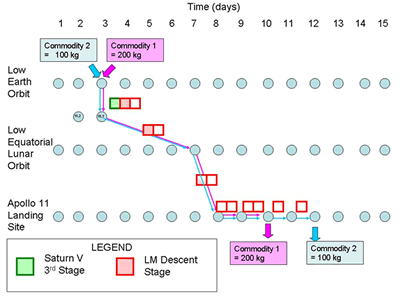The Power of Optimization
A user of the ISCMLA modeling framework can either manually input missions or ask the system to compute them from a demand scenario. In the latter case the most cost effective solution will be provided by an optimizer using state-of-the-art algorithms and solution methodologies.
Some of the most important decisions embedded in a solution are:
- Which launch vehicles to use and when to launch them?
- Which trajectories to use and what vehicles to use on each trajectory?
- Where and how the classes of supply travel on trajectories and nodes?
The user will be able to perform various what-if analysis and assess the trade-off among cost, robustness, and reliability.
Sample Mission
As a sample consider the example given below, which is based on one of the Apollo missions. In this test case we have a time horizon of 15 days, 2 supply classes (called commodity 1 and commodity 2) with their respective mass of 100 kg and 200 kg, and 2 elements. For simplicity the mission starts at LEO. The optimal 'flow' of supply classes and stacks is indicated in the figure. The demand scenario requires that commodity 1 be delivered on day 10 and commodity 2 on day 12.

We envision the largest benefit of the decision support system to be in strategic long term planning spanning a time horizon of twenty to thirty years and possibly capturing missions to Mars. We predict the most significant impact will be in areas of pre-positioning and re-fueling.
Pre-positioning
With the goal of developing a sustainable space exploration system, the ability to pre-position has become prominent. As such, the question of what to pre-position and where becomes critical in making architectural decisions. The space logistics framework allows many of these decisions to be optimized by opening up the decision space.
For example, consider the option to create a depot at the Earth-Moon Lagrangian point. Instead of evaluating a series of trade studies to determine when to store supplies at the EML1 and what supplies to store, the decision is determined by the decision support system. If the solution suggests that a large amount of a certain supply should travel to the Earth Moon Lagrangian point and remain there for some time, then the question of what to pre-position and where is decided.
Many decisions of this nature can be determined by optimizing the transfer of supplies for many missions through this integrated logistics framework.
Re-Fueling
Traditional spacecraft mission architectures assume that all propellant is launched from Earth pre-loaded in the tanks of the vehicle stages; when the propellant is consumed, the vehicle stages are generally jettisoned. As we begin to consider exploration architectures, however, it becomes clear that a large advantage can be gained if more flexible fueling strategies were available. Specifically, the ability to refuel at in-space locations has become an important issue under investigation.
The modeling framework allows for propellant stages to be refueled at some point along their travel. The power of optimization, however, lies in the ability to not dictate where, when, or even if refueling occurs. By creating the capability in the model formulation, the user can determine if this functionality is beneficial to the mission and if so, where is it most beneficial.
